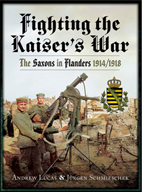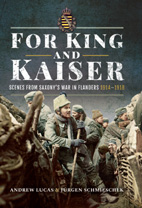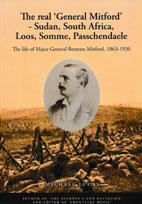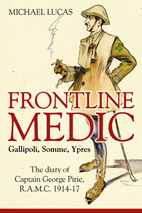Inevitably, there are matters which require correction or further addition, especially following continued research, particularly at the National Archives. Since writing Journey's End Battalion I have produced a further book and various articles, as mentioned below, which have a bearing on 9th East Surrey. My son Andrew and I also gave a talk at the National Archives based on the book, which you can listen to as a Podcast on the TNA website.
I am particularly interested in hearing from those who relatives served with the battalion.
The following remarks are offered as of possible interest.
Page x The map referred to supposedly on p.230 it is not to be found, as some small last minute cuts had to be made to the book to fit the pages available. Click here to view this map.
Page 6 A photograph of Whiteman and the Transport Section, courtesy of Phil Barber, appeared in 'Stand To!' September 2015, p.94
Pages 6-7 Unfortunately, Frankau's War Office file (WO339/11211 at T.N.A.) does not mention this feud. However, a note for reviewers survives 'This man became known as a Poet. Preserve the file on review, if the contents are worthwhile.'(!) Appointed Lieutenant in the East Surrey Regiment in October 1914, his application for transfer to the R.H.A. is dated March 1915 and signed by no one except himself. He was taken on as a 2nd Lieutenant, given no technical training and functioned as a staff officer with 24th Division's artillery. He was Adjutant to 107th Brigade from July 1915. He seems to have suffered some sort of disability, perhaps neurasthenic, from his service on the Somme. He was sent to Italy with cinematic propaganda 1916-17. General Capper had recommended him for intelligence work, which was what he wanted, but the War Office seemed unsure what to do with him. He was declared permanently unfit and retired as a captain in February 1918.
Pages 6 & 165 H.A.B. Dealtry had also previously served as an officer, briefly, with the Worcestershire Regiment 1900-01, before being cited in a divorce case. (Army List and TNA J77/728/2134)
Page 7 Mitford had later transferred to the East Surrey Regiment.
Page 12 I have edited Billman's memoir and hopefully it will appear as two parts in 'Stand To!' this year or next.
[NB: the first part has now appeared in Stand To! 118]
Page 21 Fenwick as a P.O.W. was transferred to internment in the Netherlands in April 1918, under the Hague Agreements.
Page 22 I wrote an article on Elverson, published in the Journal of the Kent Family History Society, September 2015.
Page 25 etc. I extensively revised and expanded my 2009 article on Summers. It was published in Stand To! September 2015.
Page 37 etc. I subsequently edited Pirie's diary, which was published, unabridged and with extensive introductions and notes, as 'Frontline Medic Gallipoli, Somme, Ypres' by Helion in 2014.
Page 50 A caricature of Captain Anslow, from early 1917, by Private Cole (see Page 79 note below), suggests black, yellow, red streamers on the back of the collar.
Page 51 It would be wrong to assume that the Army list is anything more than a list of officers allocated to a unit at the time.
Pages 71 and 73 Colonel Harold Tew was an officer of much experience. Born 1869 in Scotland, he saw extensive service in the Boer War. He was a major with 1st East Surrey at Mons, then commanded that battalion 1915-16. In June 1916 he was appointed to command 18th Brigade, so he seems to have suffered a demotion.
A recent photograph of the building used as Battalion H.Q. is included in Frontline Medic. It was identified from one of Sherriff's immediately post-war photographs.
Page 72 I had studied many of Sherriff's letters from his service in France and his 'My Diary' series of articles. However, because of illness, I was unable to study Sherriff's unpublished 'Memories of Active Service', before writing my book. Sherriff had written this for his mother, covering his first three months at the Front, shortly after the end of the Great War. This is now held at Surrey History Centre. Sherriff mined this for his 'My Diary' series of articles, but left a lot out, especially relating to fellow officers, like Swanton, Abrams and Tew. He also says quite a lot about his servant Morris and includes a caricature of him.
An important biography of Sherriff 'From Journey's End to the Dambusters' by Roland Wales, published by P&S, appeared in 2016. As well as covering the whole of Sherriff's career, Roland critically examines Sherriff's writings and demonstrates his novelist's liking for a good story did, on numerous occasions, conflict with the complete truth. Roland puts various material on Sherriff and 9th East Surrey on his website rolandwales.com. Another website with interesting material on the same areas is that for Surrey History Centre.
Page 73 In contradiction to one of Sherriff's own statements quoted on page 98, it appears he also served briefly with 'D' Company, under Captain Tetley, around New Year 1917.
Page 76 Sherriff, in 'Memories' agrees with Pirie that Swanton, as a martinet, quickly made himself unpopular with the battalion.
Page 79 In 2012, Di Stiff of Surrey History Centre drew my attention to a series of fourteen caricatures of officers of 9th East Surrey by Pte Edward Cole, which had recently been transferred from the regimental museum (which was subsequently sadly burnt out in the fire at Clandon Park). They are of: Anslow, Birch, Clark, Davies, Grant, Hartley, Hilton, Lindsay, Poole, Pirie, Taylor, Tetley, Thomas and Whiteman. I wrote about them in two articles for Stand To! (September 2014 and January 2015.) Six of the caricatures are also reproduced in 'Frontline Medic'.
Page 86 Mitford was not a success in his new role, commanding a Lancashire Territorial division, recently arrived from Egypt. He lost his command after six months.
Pages 95, 165 and Appendix IV Strictly speaking Abrams was dismissed from the Service, rather than cashiered.
Forster Taylor lost his commission in the Leicestershire Regiment when he went AWOL. He then served in the ranks of the Queen's Regiment in France. In November 1917 he was again commissioned. He was killed in the attack on Haussy with 9th East Surrey in October 1918. (TNA WO339/108820)
Thomas Rawson was a ledger clerk in a shipping house, who enlisted in the Pay Corps in August 1914, before re-enlisting in 1916 in the King's Liverpool Regiment. He was commissioned in April 1917.He was not court martialled, but considered unfit to hold a commission following a complaint by Cameron in September 1918. Although he had come through a traumatic time at Cambrai in late 1917, no good medical reason was found for his behaviour and it was decided he should be demobilised as quickly as possible. (TNA WO374/56390).
Cameron considered Geoffrey Sampson also 'in no way fit to command men.' However, the brigadier considered this was due to ignorance, and he served on until 1921. (TNA WO3339/56639)
Page 97 In reviewing my book in May 2013's 'Stand To!, David Filsell drew attention to Frankau's account of a post-war reunion: Sherriff turned to Clark and said 'I'm afraid I wasn't much good as an officer. I wonder if you remember, Sir, what you said to me when I was [sic] reported to you that I had just been wounded and that I was to be evacuated?'. 'Afraid I don't', smiled Nobby. 'You said, “Thank God”', remarked Sherriff; and sat down to soldierly applause.'
Page 104 The reference to Pirie from the Gallipoli book now appears to be regarding another medical officer named Pirie.
Pages 104-105 Peter Crook has pointed out to me that the Official History and the map from it on Page 105 are wrong. 72nd Brigade attacked on 24th Division’s right, and 17th Brigade on the left on 31.7.1917.
Pages 106-107 Peter Crook has pointed out that the dating of the battalion war diary here must be in error. 9th East Surrey, from other war diaries, must have relieved the two front line units on the night of 1 /2 .8.1917. Peter has also taken much trouble to establish when and where Sherriff appears to have been wounded. The line had been taken forward on 31.7.1917 with the capture of the German outpost line near Job’s Post; the main line - Jehovah Trench; and, in part, the supporting trench-Jordan. Sherriff’s company took casualties moving up on 1.8.1917. Sherriff was wounded during the day on 2.8.1917, probably near Jordan Trench. See Peter Crook’s articles - ‘R C Sherriff and Journey’s End Voices from the Great War’ in the W.F.A. Bulletin No. 111 (August 2018) and ‘How, where and when was R C Sherriff wounded in August 1917?’ in Stand To! No.115 (May 2019).
Pages 115-7 Arthur Pratt enlisted in July 1915 at 19 and was a sergeant in November 1916. His C.O. of 13th East Surreys seems to have felt uncomfortable in recommending him for a commission. 'In civilian life he was a grocer's assistant in a small shop. He was picked from the best available in my Battn.' Pratt was commissioned June 1917 and joined 9th East Surreys in August. He was killed, in temporary command of 'B' Company, on the first day of the Kaiserschlacht. His body was not recovered. His mother advised that he left no other estate than his army pay. (TNA WO339/95640)
Page 121 Haig was rather dismissive of 'Teeny' Watts, then commanding 21st Brigade, in his diary for February 1915. He wrote 'a plucky hard little man, with no great brains'. Born in 1859, he had been 'dugout' of retirement in 1914. He commanded 7th Division 1915-17, in succession to Thompson Capper, John Capper's brother, killed at Loos, before being given his Corps in 1917.('Douglas Haig War Diaries and letters' edited by Sheffield and Bourne.p.103.) Gough in his 'The Fifth Army', however, pays tribute to Watts as 'a spare, active man, quiet and very modest in demeanour, but one of the most courageous and experienced of our commanders.'
Page 150 The West Kents made some criticism of the battalion. ‘After several days of active patrolling it became clear that the map references they had been given by the East Surreys showing the forward posts did not tally with the actual posts held’. This led to the ‘Dean’s Post’ action, in .which Lt. Dean, serving with the West Kents, won the V.C. (Donald Dean V.C. ed. Terry Crowdy p.49).
Page 153 The map scale shown is incorrect.
Page 156 Williams' account of his alarming experience is in TNA WO374/74652.
Page 166 The percentage of combat fatalities to total serving should read 27%. Of course, not all officers who left the battalion survived the War. Among others, Philip Mighell died of wounds October 1917, serving with the R.F.C. James Monro never fully recovered from shell wounds received at Delville Wood. He relinquished his commission in April 1918, but was drowned, as a civilian, in October 1918, when the liner Hirano Maru, was torpedoed.
Page 167 The survival rate for records in the so called 'Burnt Records' series for those who served with the East Surrey Regiment looks relatively poor. Ironically, the surviving record rate for those who died seems to be significantly higher than for the others. One can only presume that the 'deads' were filed separately, and their location meant that they suffered less from fire and water in the burning of the Army's record depository in Arnside Street, in 1940. Besides Summers, the records of J.H.L. Dacey provides detail on a promotion from the ranks of this battalion. A house furnisher, born 1897, he attested 20.1.16. After initial service with the Royal Fusiliers he was with 9th East Surrey from September 1916 and was soon promoted corporal and lance sergeant. He was wounded, gassed and buried once each. He applied for a place at an officer cadet battalion for a commission in the R.F.A. His cadet report rated his Power of Command and Leadership 'Very Fair. Can think for himself.' Remarks 'A hard working cadet; quite good at practical work; paper work at times uncertain but did well in W.O. exam which he passed.' Commissioned in the Ox & Bucks L.I. (his 1st choice of unit) 9th September 1918. He reached the B.E.F. in November 1918. (TNA WO374/17537). There is a picture of him in Billman's papers at I.W.M.
Page 169 Clearly, the battalion was extremely raw and in a bad state after Loos. According to the diary of N.A.C. Weir, 10th Argylls, 9th Division, October 1915: ‘As our companies were only about fifty strong, we received companies from the East Surreys of the 24th Division, who had followed us up from Loos. This was really their period of trench instruction…..my East Surrey company were expecting a relief, [and] left my front line without orders. Luckily their relief, consisting of Argyll drafts, arrived soon after.’ (Mud and bodies: The war diaries and letters of Captain N.A.C.Weir 1914-20 ed. Saul David p.42-43).
Page 176 J. Lewis Stempel in 'The War behind the wire' gives the official death rates for German prisoners in Britain as 3.04%, but 7.09% for British O.Rs. in Germany, whilst arguing that the latter figure is a substantial underestimate because of unregistered deaths. It seems that Private Samuel Argyle was one of 2,000 unfortunate P.O.W.s sent by the Germans to labour on the Eastern Front. This was intended as a reprisal for the British supposedly exposing German P.O.W.s to shellfire when required to work in France. In February 1917, 500 were sent to work on German trenches between Riga and Mitau (now Jelgava, Latvia). Conditions were terrible and there was deliberate mistreatment of the P.O.W.s. Around 30 died and were buried in Nikolai Cemetery, Mitau. Most of the remainder required hospital treatment. Conditions improved in June, following British concessions. The P.O.Ws. were returned to Germany in November. (See Richard van Emden 'Meeting the Enemy-The Human Face of the Great War' pp 226-38.)
Page 177 My article on Charlie Woodbury was published in The W.F.A. Bulletin No.113 (April 2019).
Page 179 My article on Reg Howship was published in Your Family Tree magazine in April 2011.
Page 184 When I read Sherriff's 'Memories of Active Service', it became clear that the war weary Captain Hilton had also contributed to the character of Stanhope. I recommend Robert Gore-Langton's 'Journey's End - The classic war play explored' published by Oberon, 2014, as well as Roland Wales' book, as previously mentioned, for further examination of the play.
Page 188 Gilbert Frankau was a Flying Officer in the Air Ministry's Directorate of Intelligence by May 1940. Walter Summers rose to be a Wing Commander in the R.A.F's. Balloon Branch. (see Air Force List). Amongst the many who must have served in the Home Guard, was George Stanbury, veteran of 9th East Surrey at Loos and of 172 Tunnelling Company.
Photograph 6 Following sight of the Cole caricatures and discussion with Roland Wales, there are more identifications to add: first row extreme right - Captain Tetley, second row fourth left - 2/Lt. D.L. Hatten, sixth left - 2/Lt. T.E.S. Reynolds, extreme right - 2/Lt W.H. Lindsay; third row third from left - 2/Lt. H. Kiver.
Photograph 19 Captain Whiteman is in the front row, 9th from the left, not as indicated.
Appendix I - Roll of Honour Unfortunately, the following were omitted by me:
1780 L/Cpl. William George Webb, enlisted Reigate, Surrey, kia 26.9.15
4805 Pte. George Thomas Soanes, enlisted Huntingdon, kia 25.1.17
27282 Pte. William Miller, enlisted Camberwell , dow.16.10.18
33756 Pte Edwin Lambert, enlisted Canterbury, d. (as POW), 22.10.18.
This means that the totals should be 872 total deaths, 656 k.i.a., 160 d.o.w., 56 d. The various conclusions on the origins of the men at various times may be slightly skewed as a result, and Appendix II Fatalities by Month becomes slightly incorrect.
Appendix III Awards and decorations I have since found some more in the Brigade war diary for early 1917, looking for other information:
Pte. C. Baker - awarded an M.M. in February for the January raid - had the serial no.182.
6735 Pte. C.A. Pearson was also awarded an MM for this raid.
4422 Sgt. D.O.L. Robertson and 830 Corporal (Lance Sergeant) T.Harris received.
MMs in March 1917 - Robertson had previously been honoured for the Somme.
Appendix IV - Officers Also left off the original roll prepared by the battalion is Second Lieutenant D. McLaren, wounded at Loos, 26.9.15, and listed in the war diary as a casualty there.
Michael Lucas, 11 May 2020





